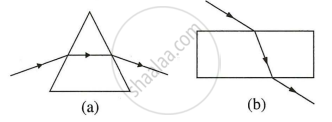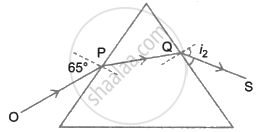Advertisements
Advertisements
प्रश्न
How will you use two identical prisms so that a narrow beam of white light incident on one prism emerges out of the second prism as white light? Draw the diagram.
उत्तर
Angle of deflections of the two prisms need to be equal and opposite. While the first prism splits the light in the seven colours due to different angles of deflection, the second prism combines the spectrum along a single ray and the colours again combine to give white light as the emergent light.

संबंधित प्रश्न
The deviation produced by a prism is independent of the angle of incidence and is same for all the colours of light.
Diagrams (a) and (b) in figure below show the refraction of a ray of light of single colour through a prism and a parallel sided glass slab respectively.

- In each diagram, label the incident, refracted, emergent rays and the angle of deviation.
- In what way the direction of emergent ray in the two cases differ with respect to the incident ray? Explain your answer.
A ray of light incident at an angle of incidence i1 passes through an equilateral glass prism such that the refracted ray inside the prism is parallel to its base and emerges at an angle of emergence i2.
- How is the angle of emergence ‘i2’ related to the angle of incidence ‘i1’.
- What can you say about the angle of deviation in such a situation?
An object is viewed through a glass prism with its vertex pointing upwards. Draw a ray diagram to show the formation of its image as seen by the observer on the other side of the object.
A ray of light is normally incident on one face of an equilateral glass prism. Answer the following:
What is the angle of refraction from the first face of the prism?
A ray of light is normally incident on one face of an equilateral glass prism. Answer the following:
Will the light ray suffer minimum deviation by the prism?
A ray of light incident at an angle of incidence 48° on a prism of refracting angle 60° suffers minimum deviation. Calculate the angle of minimum deviation.
[Hint: δmin = 2i - A]
Assertion: The light emerges from a parallel-sided glass slab in a direction perpendicular to that in which enters the glass slab.
Reason: The perpendicular distance between the original path of the incident ray and the emergent ray coming out of the glass slab is called lateral displacement of the emergent ray of light.
Assertion: When a pencil is partly immersed in water and held obliquely to the surface, the pencil appears to bend at the water surface.
Reason: The apparent bending of the pencil is due to the refraction of light when it passes from water to air.
The diagram below shows the ray OP travelling through an equilateral prism of a certain material.
- Calculate the value of i2, if the angle of deviation is 43°.
- What is the ray QS called?

